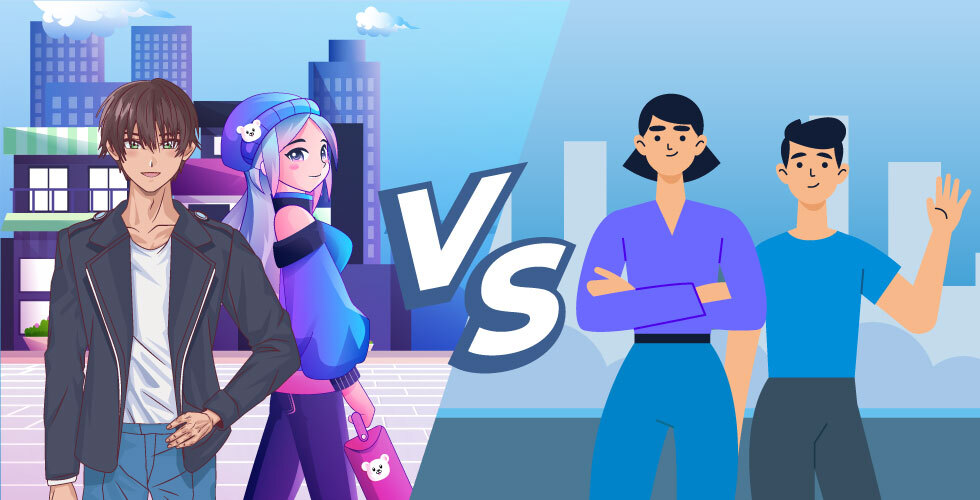If you are a fan of animated movies and shows, you might have wondered what is the difference between anime and animation. Anime and animation are both forms of visual storytelling, but they have some key differences.
Anime is a specific style of animation that originates from Japan. They feature vibrant characters with exaggerated features and intense emotions. On the other hand, animation is a broader term that encompasses all forms of animated content regardless of the country of origin or artistic style.
So while all anime is a type of animation, not all animation is considered anime. In this article, we will explore the history, style, and genres of anime and animation, and how to recognize them easily.
What Is Anime?
Let’s start with a story.
Meet Lisa, a college student who loves watching animated shows. She has a huge collection of DVDs and streaming subscriptions for various shows.
One day, she decides to try something new and watch a show that her friend recommended. It’s called Death Note, and it’s about a high school student who finds a notebook that can kill anyone whose name is written in it. Lisa is intrigued by the premise and starts watching the first episode.
As soon as she sees the opening scene, she notices something different. The characters have large eyes with reflective highlights, slender and long bodies, and realistic details of the face, body, and clothes.
The backgrounds are also very detailed and colorful, creating a contrast with the dark and mysterious tone of the story. Lisa realizes that this is not a typical cartoon, but an anime.
“Anime” is a term that mainly refers to Japanese animation. The word anime is derived from the English word animation, but it has a specific meaning in Japan and abroad. it is pronounced as “ah-nee-meh”, not “an-ee-may” as some Westerners might say.
Anime is characterized by its distinctive art style, which often features large eyes, exaggerated expressions, and detailed backgrounds. Anime also covers a wide range of genres and themes, from comedy and romance to action and horror.
Anime has a long history that dates back to the early 20th century when the first Japanese animators experimented with various techniques and influences. However, anime, as we know it today, emerged in the 1960s, thanks to the work of Osamu Tezuka, who is widely regarded as the father of modern anime.
Tezuka created iconic works such as Astro Boy, Kimba the White Lion, and Princess Knight, which established many of the conventions and tropes of anime storytelling. Some of the most famous anime directors include Hayao Miyazaki, Mamoru Oshii, Satoshi Kon, Makoto Shinkai, and Hideaki Anno.
Anime can be found in various formats, such as TV series, movies, OVAs (original video animations), ONAs (original net animations), and web series. Anime can also be adapted from manga (Japanese comics), light novels (Japanese novels with illustrations), video games, or original stories.
Anime is not a genre, but a medium that encompasses a variety of genres and themes. Anime can target different audiences, from children to adults, and deal with topics ranging from comedy and romance to action and horror.
Some of the most popular genres of anime include shonen (aimed at young boys), shoujo (aimed at young girls), seinen (aimed at adult men), josei (aimed at adult women), mecha (featuring giant robots), isekai (featuring characters transported to another world), and slice of life (featuring everyday situations).
What Are the Most Popular Anime Franchises?
Some of the most popular anime franchises are:
- Dragon Ball: A shonen anime that follows the adventures of Goku, a martial artist who seeks the seven mystical Dragon Balls that can grant any wish.
- Naruto: A Shonen anime about a young ninja who dreams of becoming the leader of his village.
- Your Lie in April: A slice-of-life anime about a piano prodigy who meets a violinist who changes his life.
- One Piece: A Shonen anime about a pirate crew led by Monkey D. Luffy, who aims to find the legendary treasure One Piece and become the King of the Pirates.
- Death Note: A Seinen anime about a high school student who finds a notebook that can kill anyone whose name is written in it.
- Pokemon: A children’s anime based on the video game series of the same name, where humans capture and train creatures called Pokemon to battle each other.
- Sailor Moon: A shoujo anime about a group of teenage girls who transform into magical warriors to fight evil.
- Nana: A josei anime about two young women with the same name who become friends and pursue their dreams in Tokyo.
- Evangelion: A mecha anime about a group of teenagers who pilot giant robots to fight against alien invaders.
- Studio Ghibli Films: A collection of animated films produced by Studio Ghibli, a renowned Japanese animation studio founded by Hayao Miyazaki and Isao Takahata. Some of their most famous films include Spirited Away, My Neighbor Totoro, and Princess Mononoke.
- Re: Zero – Starting Life in Another World: An isekai anime about a young man who is transported to a fantasy world where he can rewind time every time he dies.
- Demon Slayer: A Shonen anime about a boy who becomes a demon slayer after his family is killed by demons. He joins forces with other demon slayers to find a cure for his sister, who has been turned into a demon.
Anime fans normally watch these shows in original format with English subtitles.
What Is Animation?
Now let’s switch to another story.
Meet Tom, a graphic designer who works for an animation studio. He loves creating animated characters and scenes for various projects. He has worked on commercials, music videos, explainer videos, short films, and web series.
Your Message
With Animation

Transform Your Message With Animation




One day, he gets assigned to work on a new project. It’s called Zootopia, and it’s about a city where animals live together in harmony. Tom is excited by the challenge and starts working on the character design.
As soon as he sketches the first character, he notices something different. The character is a rabbit named Judy Hopps, who wants to be a police officer.
She has small eyes with expressive eyebrows, a round face with a cute nose, and fluffy ears and fur. She also wears a police uniform that fits her body shape. Tom realizes that this is not an anime, but an animation.
Animation is a general term that refers to any form of art that creates the illusion of movement by displaying a sequence of static images. Animation can be done using different techniques, such as hand-drawn animation, computer animation, stop-motion animation, clay animation, puppet animation, and more.
By the term “animation movies”, we refer to cartoons; mainly non-japanese style cartoons. However, that’s not always appropriate actually. Anyway, the topic of “cartoons vs animations” is a whole other topic for another day!
Animation can also be produced in different countries and cultures, such as American animation, European animation, Chinese animation, Korean animation, etc.
Animation has a long history that dates back to ancient times, when people used various methods to create moving images, such as shadow puppets, flip books, zoetropes, and magic lanterns.
The first animated film was made in 1906 by French artist Emile Cohl. Since then, animation has evolved and diversified into many forms and styles.
Animation can also be found in various formats, such as TV series, movies, shorts, commercials, music videos, and web series. Animation can also be adapted from comics, books, video games, or original stories.
The Most Popular Animation Movies
Some examples of animation are:
- The Lion King: A hand-drawn animated film by Disney that tells the story of a young lion who must reclaim his throne from his evil uncle.
- Toy Story: A computer-generated animated film by Pixar that depicts the adventures of a group of toys that come to life when their owner is not around.
- Wallace and Gromit: A stop-motion animated series by Aardman Animations that follows the exploits of an eccentric inventor and his loyal dog.
- South Park: A cutout animated series by Comedy Central that satirizes various aspects of American culture and politics.
- The Legend of Zelda: Breath of the Wild: A video game by Nintendo that features cel-shaded animation that creates a stylized and immersive open-world experience.
- Homestar Runner: A web series by The Brothers Chaps that features flash animation that parodies various genres and tropes.
Some of the most popular animation franchises include Disney films, Pixar films, Looney Tunes, SpongeBob SquarePants, and The Simpsons.
How to Tell the Difference Between Anime and Animation?
While anime and animation share some similarities as forms of art that use moving images to tell stories, they also have some differences that can help you distinguish them.
Here are some of the main differences between anime and animation:
| Anime | Animation |
| A Japanese style of animation that is often characterized by its distinct art style, storytelling, and themes. | A broad term that encompasses any form of moving images, including cartoons, computer-generated imagery (CGI), and stop-motion animation. |
| The term anime is actually short for animation. | The term animation is mostly used when we are talking about non-Japanese-style cartoons. |
| Anime pays more attention to the design of the setting and characters, whereas animation pays more attention to motions and movements. | Animation includes a great deal of animated motion, whereas anime involves less animation of movement. |
| Anime characters have distinct facial expressions, such as large eyes with reflective highlights, and slender and long bodies. | Cartoon characters have features that are much closer to reality, but still exaggerated for a comic effect. |
| Anime is watched by different age groups and can deal with serious and complex subject matter, as well as mature content that may include sex and violence. | Animation targets the young audience and usually deals with adventures and silly humorous situations. |
Art Style
Anime tends to have more detailed and realistic backgrounds, while animation tends to have more simplified and stylized backgrounds.
Anime also tends to have more exaggerated and expressive facial features, such as large eyes, small mouths, and sweat drops, while animation tends to have more natural and subtle facial expressions.
Animation has a more varied art style that can range from realistic to cartoonish, from simple to complex, and from colorful to monochrome.
Motion
Anime tends to have less animation of movement, relying more on still frames, camera angles, and sound effects, while animation tends to have more animation of movement, using more keyframes, fluid motions, and physical comedy.
Audience
Anime targets different age groups, from children to adults, and can deal with serious and complex subject matter. Anime can also contain mature content that may include sex and violence.
Animation movies target mainly children and families and usually deal with humorous and adventurous subject matter. Animation can also contain mature content, but it is usually more subtle or satirical.
Origin
Anime is usually produced in Japan, or by Japanese studios or artists, while animation can be produced anywhere in the world, or by studios or artists from different countries.
However, this is not a definitive criterion, as some anime can be influenced by other cultures, and some animations can be inspired by anime.
Some anime that are influenced by other cultures are:
- Cowboy Bebop: A sci-fi anime that mixes elements of Western, noir, and jazz culture.
- Samurai Champloo: A historical anime that blends samurai action with hip-hop culture.
- Fullmetal Alchemist: A fantasy anime that is influenced by European culture, history, and philosophy.
Some animations that are inspired by anime are:
- Avatar: The Last Airbender: An American animated series that depicts a world where some people can manipulate the four elements: air, water, earth, and fire. The series is inspired by various Asian cultures, religions, and martial arts, as well as anime styles and tropes.
- RWBY: An American web series that is inspired by various fairy tales, myths, and legends, as well as anime genres and aesthetics.
- Miraculous: Tales of Ladybug & Cat Noir: A French animated series that is inspired by superhero comics, magical girl anime, and French culture and landmarks.
Content Style
Anime and animation have a clear and noticeable difference in their content style.
Animation movies are mostly based on Western or global themes, while anime showcases Japanese culture, history, and art. Anime often has dark and mature themes that appeal to adults, while animation movies are mostly suitable for children.
There are some exceptions, but anime is generally darker than animation.
Genre
Anime covers a wide range of genres and themes, such as mecha (giant robots), space opera (sci-fi adventure), cyberpunk (dystopian future), isekai (transported to another world), harem (multiple love interests), slice-of-life (everyday life), and more.
Animation can also cover a variety of genres and themes, but some of them are more common or unique to animation, such as musicals, superheroes, or parodies.
How Does ‘Anime’ Achieve Such Amazing Animation?
When you watch an American cartoon, you might notice that the characters are constantly moving, blinking, and gesturing. This is because each episode has about 30,000 frames of animation, which creates a smooth and fluid motion.
However, this also means that the art style has to be simple and easy to draw. For example, look at this scene from an American animated movie “Frozen”:
On the other hand, when you watch a Japanese anime, you might notice that the characters are often still, with only their mouths or eyes moving. This is because each episode has only about 3,000 frames of animation, which saves time and money.
However, this also means that the art style can be more detailed and expressive. For example, look at this scene from a Japanese anime “One Piece”:
The difference between American cartoons and Japanese anime is not just about quality, but also about efficiency. Japanese anime uses a technique called “sakuga”, which means “drawing pictures”.
Sakuga is the art of choosing when to animate a scene fully and when to use shortcuts. The idea is to create the most impact with the least effort. This technique was invented by Osamu Tezuka, the father of modern manga and anime.
In Japanese anime, most scenes are static, with only minimal movement. The animators use artistic poses and camera angles to convey the mood and atmosphere of the scene.
They also use a lower frame rate, around 10 frames per second, compared to 24 frames per second in American animation. This way, they can save on drawing and redrawing cels (the transparent sheets used for traditional animation).
However, in some scenes, especially during battles or emotional moments, the animators use sakuga to create dynamic and stunning animation. They use a higher frame rate, more drawings, and more movement to show the action and emotion of the scene.
They also use more colors, effects, and details to enhance the visual appeal of the scene. For example, in this scene from One Punch Man, Saitama punches Genos with incredible force:
As you can see, Japanese anime uses sakuga to balance animation and art. By using shortcuts in most scenes and splurging on key moments, they can create visually striking animation even with a limited budget and time.
Some anime have more sakuga than others, depending on the genre and the studio. For instance, Attack on Titan is a high-budget anime that has more frames per episode than average.
Anime is not bad at animation; it is just different from American cartoons. It is a form of art that uses efficiency and creativity to tell a story with images. It is the contrast between the highs and lows that makes anime so memorable and impressive.
Final Thoughts
Anime and animation are both amazing forms of art that can entertain, educate, and inspire us. They both have their own strengths and weaknesses, and they both appeal to different tastes and preferences.
There is no right or wrong answer when it comes to choosing between anime and animation. The best thing to do is to explore both options and find out what you like and enjoy.
Transform Your Message With Animation




Is Japanese Anime Superior to Western Animation (Which Some Anime Fans Claim)?
To illustrate this point, let me tell you a personal story. When I was a kid, I loved watching cartoons on TV. I was fascinated by the colorful characters and the funny situations they got into. I especially liked shows like Tom and Jerry, Looney Tunes, and The Simpsons. I thought cartoons were the best thing ever.
Then one day, I stumbled upon a show that looked different from the cartoons I was used to. It was called Dragon Ball Z. It had characters with spiky hair and glowing eyes, who could fly and shoot energy blasts.
It had epic battles and dramatic twists. It had a story that spanned across multiple sagas and planets. It was unlike anything I had ever seen before.
I was hooked. I started watching more shows like Dragon Ball Z. I discovered other genres and styles of anime. I learned about the culture and history behind anime.
And eventually, I became a fan of anime; so big fan that I ended up watching One Piece (the biggest anime in history) with more than 1000 episodes (still ongoing).
But that didn’t mean I stopped liking cartoons. I still enjoyed watching animation from different countries and eras. I appreciated the diversity and creativity of animation. I became a fan of animation.
Nowadays, I watch both anime and animation movies regularly. I don’t compare them or judge them based on their differences. I appreciate them for their similarities and their uniqueness. I enjoy them for what they are: amazing forms of art.
So if you are curious about anime or animation, don’t be afraid to try something new. You might discover something you love. Or you might find out that you love both. Either way, you will have a lot of fun!







